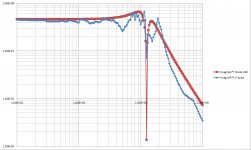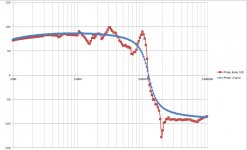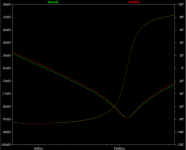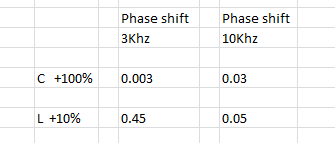With the very noisy data recorded with the Bode 100 that I kindly received from Jack, see Cartridge dynamic behaviour, I have compared these data to my LTspice model: (0.46mH + 800 ohm) //800K//3.6pF.
The images below are showing both Phase and Inductance the same way as the HP3577A does.
Results are very comparable, telling that the LTspice model is quite close to the ATM540L.
Hans
The images below are showing both Phase and Inductance the same way as the HP3577A does.
Results are very comparable, telling that the LTspice model is quite close to the ATM540L.
Hans
Attachments
By this argument, as to my post above, the ref input would need a separate 40dB 50R low noise amp as well. And it would need to be fairly well gain/delay matched to the 40dB amp on the main input.
At least we only need 200kHz or so, HP's accessories will all be intended for the full instrument BW.
I have started testing using my REW impedance rig and my old G1042.
I have to calibrate absolute levels yet, but over 40dB range I see no change in inductance at all.
I have to calibrate absolute levels yet, but over 40dB range I see no change in inductance at all.
I have started testing using my REW impedance rig and my old G1042.
I have to calibrate absolute levels yet, but over 40dB range I see no change in inductance at all.
To what level of precision?
Jack,To what level of precision?
What about my suggestion Cartridge dynamic behaviour.
Are my assumptions correct and is this possible ?
Hans
Hi Hans yes that gets the excitation level on the coil small enough. That leaves whether the phase detector can work well enough at such levels to fish phase info out of the mire. It might but prob wont and is easy to try so why not?Jack,
What about my suggestion Cartridge dynamic behaviour.
Are my assumptions correct and is this possible ?
Hans
LD
Hi Davidsrsb if it happens at all it will be at small levels by programme standards.I have started testing using my REW impedance rig and my old G1042.
I have to calibrate absolute levels yet, but over 40dB range I see no change in inductance at all.
LD
Hi LD,Hi Hans yes that gets the excitation level on the coil small enough. That leaves whether the phase detector can work well enough at such levels to fish phase info out of the mire. It might but prob wont and is easy to try so why not?
LD
According to the image below, with 47dB SNR, phase error will be below 1 degree and magnitude error below 0.1dB.
Hans
Attachments
Jack,
What about my suggestion Cartridge dynamic behaviour.
Are my assumptions correct and is this possible ?
Hans
I will try it.
In the table below, one can see what 100% variation of the Cap and 10% variation in L does to the phase at 3kHz and at 10kHz.We need to look seriously at the sensitivity to model fit. Here is -10% on L and +10% on C. This would be buried in the noise that has been shown so far.
But because phase is close to 90 degrees, a bit of noise on the phase doesn't hurt to calculate the imaginary from the complex modulus |Z|.
Maybe it would therefore be even better to measure at 10kHz instead of 3kHz, because at this frequency phase is closest to 90 degrees, giving probably the highest accuracy in calculating L.
Hans
Attachments
phase is close to 90 degrees, a bit of noise on the phase doesn't hurt to calculate the imaginary from the complex modulus |Z|.
Hans with all due respect this statement is nonsense, the modulus is real not complex and you don't calculate the imaginary from something, you measure magnitude and phase Euler's equation gives you the direct correspondence to real and imaginary part.
This is true. It's well within DIY grasp.At least we only need 200kHz or so, HP's accessories will all be intended for the full instrument BW.
LD
Scott,Hans with all due respect this statement is nonsense, the modulus is real not complex and you don't calculate the imaginary from something, you measure magnitude and phase Euler's equation gives you the direct correspondence to real and imaginary part.
And with much respect from my side, the magnitude that is measured is |Z| and is real, being by definition the complex modulus of Z.
And yes, with the phase you have to calculate from |Z| the re and the im magnitude.
But the magnitude from im1=|Z|sin(88 degrees) differs only 0.04% from im2=|Z|sin(89 degrees).
That's why I meant to take a frequency where the phase is closest to 90 degrees as possible, which is the case at 10kHz, getting L with the highest accuracy.
Hans
Scott,
And with much respect from my side, the magnitude that is measured is |Z| and is real, being by definition the complex modulus of Z.
Sorry Hans we just have some kind of terminology problem, complex modulus makes no sense (to me). The modulus (magnitude) is a real number there is no imaginary part. It just makes a layer of translation for me to see what you mean.
The ratio "A/R" turns out to be "problematic" at very low levels for the HP3577 -- may be owing to the way this 1984 instrument performs the calculation, noise, etc. (I'm guessing you don't have enough "bits" in the low range level.)
Hi Scott what Hans is saying is that the real part of Z at 10kHz is << imaginary part. So magnitude of Z tells us what we wish to know ie magnitude of imaginary part of Z.Sorry Hans we just have some kind of terminology problem, complex modulus makes no sense (to me). The modulus (magnitude) is a real number there is no imaginary part. It just makes a layer of translation for me to see what you mean.
That's true until we add the loss mechanism we are looking for. Then vector isn't 90 anymore so all bets off. I think we do need to measure phase unfortunately.
LD
Hi Scott, no problem, but obviously I'm not the only one using this terminology Complex Modulus 😀Sorry Hans we just have some kind of terminology problem, complex modulus makes no sense (to me). The modulus (magnitude) is a real number there is no imaginary part. It just makes a layer of translation for me to see what you mean.
Complex modulus - Wikipedia
Hans
The ratio "A/R" turns out to be "problematic" at very low levels for the HP3577 -- may be owing to the way this 1984 instrument performs the calculation, noise, etc. (I'm guessing you don't have enough "bits" in the low range level.)
Hi Jack,
That would be a shame, when resolution turns out to be the deal breaker.
The HP3577 spec's are a bit vague on that, but they mention that at levels between -90 dB to -100dB below Full Scale Input, resolution with 10Hz BW is still +/-0.75dB.
When taking +15dBm or 1.26V as Full Scale input, -100dB would be 12.6 uV.
That is still- above the 22uV that I was suggesting with the -40dBm setting + 40dB attenuation with 5K - 50 Ohm.
So do I make a wrong interpretation of the spec's ?
Hans
Hi Scott what Hans is saying is that the real part of Z at 10kHz is << imaginary part. So magnitude of Z tells us what we wish to know ie magnitude of imaginary part of Z.
That's true until we add the loss mechanism we are looking for. Then vector isn't 90 anymore so all bets off. I think we do need to measure phase unfortunately.
Yes I apologize again for mis-understanding. The observed measurements presented sometimes show 10 or more degrees of phase error so direct application of minimum phase theory would possibly miss what we are looking for.
- Status
- Not open for further replies.
- Home
- Source & Line
- Analogue Source
- Cartridge dynamic behaviour




